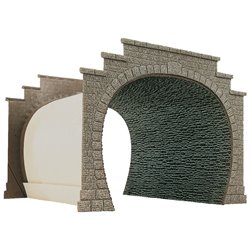Static grass puffer bottles work by manually charging model grass fibres with static electricity. When the charged...
No products
Product successfully added to your shopping cart
There are 0 items in your cart. There is 1 item in your cart.
Search Tips
What is a tunnel liner?
A tunnel liner is a sheet of scale brickwork, often moulded for detail and constructed from plastic, used to represent the internal wall of a model railway tunnel.
Tunnel liners are designed to fit onto a special lip on the back of most tunnel portals for a gap-free join. The lip also helps you to form a near-perfect shape for the inside of your tunnel. Not all modellers opt to use liners depending on the type of tunnel they're modelling, so not all portals have the lip and you will need to check for this when choosing a portal.
The interior wall of a tunnel can be fashioned by printing your own brickwork onto a piece of card and attaching it to your portal in the same way, but this method can look a little flat and shiny especially if you operate any locomotives with working headlights. The embossed brick pattern of a purpose-made tunnel liner will avoid this problem and add a great deal of realism to your tunnel scene.
Click here to receive the tips weekly in your mailbox. You can unsubscribe at any time.









